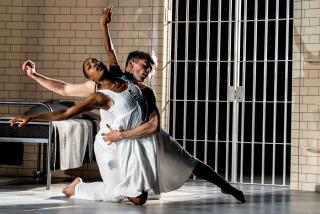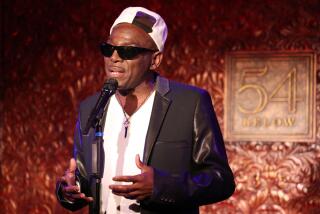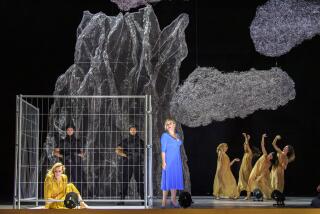ABT’s ‘Sleeping Beauty’ at Segerstrom a lush return to tradition
For most of its storied history, New York’s American Ballet Theatre has tried to master all styles of all types of classical dance, an elusive goal that some critics have called impossible.
While European companies have moved on to radical rewrites of the full-length story ballets, ABT has maintained a more traditional, and unsatisfying, course. The right manner and expression, the sheer dancer-power and theatrical trappings, all of which are needed to make the 19th century classics living art, have been missing.
But the company made a glittering course reversal Tuesday night with the world premiere at the Segerstrom Center for the Arts of Alexei Ratmansky’s “The Sleeping Beauty,” a sumptuous three-act production based on Marius Petipa’s 1890 original.
Ratmansky, the company’s choreographer in residence and truly our most exciting ballet-maker, scoured written source material to unearth primary steps and gestures preserved in notation. Where there were gaps, he has filled in with his own sensitively drawn phrases.
The real breakthrough, though, is how Ratmansky and his wife, Tatiana, who assisted him, have coached the dancers to reach a remarkable cohesion and a thorough artistry. A newfound dancing style matches steps with music — finally.
From the corps de ballet to the soloists, arms were softly supple and heads always at proper angle to the body. Dancers focused on musicality rather than gymnastic pyrotechnics. The stage overflowed with perfectly aligned rows of bodies, at least 70 company members and more than 100 supernumeraries (adults and children) throughout the night. This is the pop-up fairy-tale book as Petipa intended it, a richly told story of love eternal.
The remarkable change was evident from the beginning prologue, the scene in which baby Aurora is blessed by her godmother fairies and then cursed by the evil Carabosse. Each fairy variation was a model of decorum and refinement, with each woman blossoming through the steps. The company has learned to dance with its eyes, even — and, oh, what an impact that makes.
The ballet’s design was more variable. Richard Hudson’s bold costumes and realistic sets were inspired by Russian painter Léon Bakst’s designs for the Ballets Russes’ “Sleeping Princess” of 1921.
The nobles are spectacularly gowned, and perhaps half the cast is hatted and bewigged, with the Queen’s Act 1 stand-up hairdo a “Young Frankenstein” knockoff. The Garland Waltz is a conglomeration of eye-popping hues, bordering on color clash, including mustard and turquoise outfits for the Waltzers and green and red outfits for the Violin Pages.
But the Lilac Fairy changes into a tiered gown and white wig with feather that makes her look like a Wild West saloon gal. One of the fairy head ornaments has ridiculous flouncy antennae. The final act, though, is a shimmering spectacle of white and gold and truly breathtaking.
Marcelo Gomes was the opening-night Prince Désiré and Diana Vishneva his Aurora. Her idiosyncratic portrayal — though full of meaning and warmth — did give pause. Wide-eyed and slightly open-mouthed, she played the little princess as naive child, acting 12 rather than 16. Her delicacy bordered on limpness and her efforts to evoke period truthfulness made her look wispy as
she sloshed through transitions.
A gifted artist, Vishneva seemed loath to draw any attention to her considerable athleticism, as though this would betray the ballet’s spirit. Gomes, though, performed with brio and ardor. His Act 3 solo is in this version a wicked test of across-the-floor beats and in place high jumps, rivaling that of the Blue Bird solo. He passed delightfully.
Both veteran and younger dancers filled the cast. The generally lovely Veronika Part was having trouble staying up on full pointe, diminishing her Lilac Fairy. Nancy Raffa, in garish makeup, played Carabosse with a fantastically ferocious wallop. Tatiana Ratmansky was the sympathetic Queen and Victor Barbee the hot-headed King Florestan.
The fairies mustered unique qualities to distinguish their solos, with Devon Teuscher’s delicacy, Misty Copeland’s attack, Sarah Lane’s crispness and Skylar Brandt’s peppy fluttering all notable. Ratmansky has changed the well-known “finger variation,” so that bent-arm motions alternate with the arrow-like straight pointing; Stella Abrera performed it with esprit.
In the wedding scene, standouts included the high-flying Daniil Simkin as the Bluebird and Cassandra Trenary as his poised and fervent Princess Florine. Her effervescence makes her a dancer to watch. Diamond Fairy Isabella Boylston brought springy leaps to her variation. It was delightful to see dances rarely included, such as the children of Hop-o’-my-Thumb with Richard Bowman as the hungry ogre and Cinderella (Gemma Bond) with her Prince (Sterling Baca).
Our next brush with Ratmansky is this December when his “Nutcracker” shifts from Brooklyn to Segerstrom Center. Bring it on.
------------
‘The Sleeping Beauty,’ American Ballet Theatre
Where: Segerstrom Hall, 600 Town Center Drive, Costa Mesa
When: 7:30 p.m. through Saturday; 2 p.m. Saturday; 1:30 and 7 p.m. Sunday
Tickets: $29 to $149
Info: (714) 556-2787, https://www.scfta.org
More to Read
The biggest entertainment stories
Get our big stories about Hollywood, film, television, music, arts, culture and more right in your inbox as soon as they publish.
You may occasionally receive promotional content from the Los Angeles Times.






